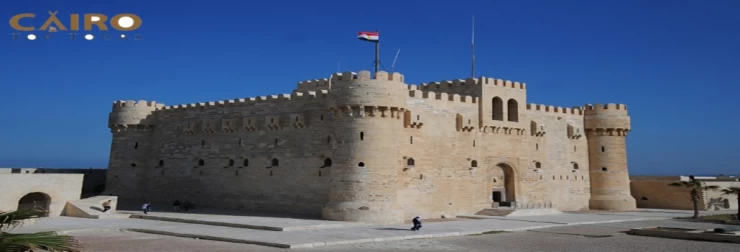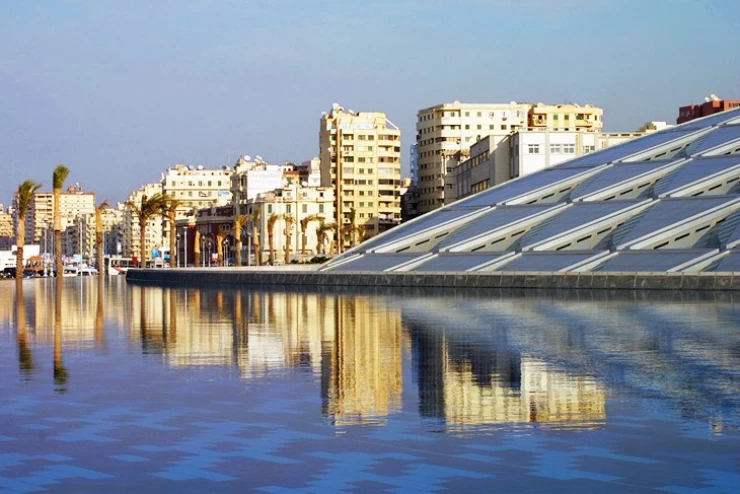-webp.webp)
The Catacombs of Kom el Shoqafa
The Catacombs of Kom el Shoqafa: A Portal to Egypt’s Greco-Roman Past
One of the remarkable archaeological discoveries from the twentieth century lies in some streets of Alexandria, underneath Egypt’s second-largest city, which revealed the Catacombs of Kom el Shoqafa.
These multidimensional catacombs represent both a burial place and an outstanding embodiment of Egypt's geographical centrality between the ancient civilizations. The catacombs at Kom el Shoqafa unite the artistic techniques of ancient Egypt, Greece, and Rome to demonstrate a unique union between ancestral architecture and religious practices, and societal ranks in one site.
The discovery of the catacomb occurred unintentionally on September 28th, 1900. Eighteen years after the excavations started in this area, the Great Tomb of Pharaoh Seti I was discovered by chance when a donkey accidentally ended up at this site at a depth of 12 m. The surviving remains in that area were known to the excavators who searched for the donkey's mysterious collapse.
Recognition by the public has placed the catacombs in a position among the seven wonders of the Middle Ages, which also include the Colosseum and the Great Wall of China.
Visitors who visit Kom el Shoqafa can learn about past Alexandrian daily routines and witness how different cultures existed together during an active period in ancient Egypt.
Part of the statues maintained an Egyptian aesthetic structure, yet presented Roman dressing and hairstyling, and replicated similar compositional aspects across various sculptures.
A circular staircase in its centre leads to the tombs that were dug into the rock during the time of the Antonine Emperors (2nd century AD).
Historical Background
During Roman rule of Alexandria in the 2nd century AD, the Catacombs of Kom el Shoqafa came into existence.
Alexander the Great established the city of Alexandria in 331 BC, after which it developed into an educational and cultural centre. After the Romans established control over the city in 30 BC, Alexandria continued to exhibit its multiracial character by unifying Egyptian heritage with Hellenistic and Roman cultural traditions.
Kom el Shoqafa started its existence as a personal burial site owned by an affluent Greco-Egyptian family. Through successive burials, the catacombs grew into an open public burial ground for the citizens. The interred members of this tomb belonged to an Alexandrian family whose inscription and artwork display signs that they blended Egyptian customs with Greek cultural elements.
The cemetery stands out because of its extensive nature and rich ornamentation, together with its intricate organization.
The necropolis stands as both the highest representation of Roman-Pharaonic fusion in Alexandria and one of the most exquisite structures for burial purposes. The site gained its name from the enormous quantity of pottery and visitor rubbish that accumulated in the area.
Excavation
Archaeological investigations revealed a vast multilevel tomb network that lay undiscovered for centuries since its burial period was covered by soil sediment.
Research activities for the site took place through decades of work between Egyptian and international scientific teams.
Archaeologists in the middle of the twentieth century meticulously cleaned the catacombs before letting visitors explore them.
Kom el Shoqafa exists as a vital archaeological site for Egyptologists, together with classical historians, despite its lesser prominence compared to the Giza Pyramids and the Valley of the Kings.
Architectural Design and Layout
People can explore 35 meters (115 feet) of catacombs hewn from solid bedrock through a central spiral staircase.
The three main levels in this complex remain accessible except for the lowermost area because of water seeping through. These catacombs demonstrate outstanding engineering skills together with meticulous planning and decorative artistic features.
The Spiral Staircase
Descending passengers start their journey down by using the wide stairway that circles the core shaft. People used to lower their bodies through the shaft through a rope-and-pulley system before burial.
The Rotunda and Triclinium
Under the staircase steps, one will find the rotunda, which operates as a circular hall between two areas. Several marble benches decorate the walls inside the triclinium, which is located next to the rotunda. The space functioned for commemorative feasts that held family members for Roman funerary traditions.
The Main Burial Chamber
The structure located beyond the rotunda contains the Hall of Caracalla, although many mistakenly attribute it to Roman Emperor Caracalla.
The most essential burial chamber in the catacombs contains significant elements that unite Egyptian customs with Greco-Roman artistic characteristics.
Standing in the middle lies an expansive tomb, which stands protected by sculpted decorations and columns and sarcophagi placed in niches.
Symbolism and Artistic Fusion
The art and decoration within Kom el Shoqafa reflect the syncretic culture of Roman-era Alexandria. Elements from Pharaonic Egypt, classical Greece, and imperial Rome are seamlessly integrated, creating a visual narrative of cultural hybridity.
Egyptian Themes
Traditional funerary deities, along with hieroglyphs and lotus flowers, decorate all surfaces of the catacombs, where Anubis (the jackal-headed god of mummification) stands alongside Isis. Anubis frequently appears in a Roman military outfit, which displays a combination of different symbolic elements.
Greek and Roman Elements
This structure utilizes Corinthian columns and pediments together with classical friezes as major architectural elements. Portraiture busts and toga-clad figures and Greco-Roman funeral customs reside side by side with Egyptian conventional symbols within this site.
The architectural diversity expressed an important concept about the identities of buried individuals living in a historic area where Greek philosophy integrated with Roman law and Egyptian religious beliefs.
Cultural Significance
Throughout the Roman period, Alexandria experienced its multicultural character openly through the burial site known as Kom el Shoqafa. This site shows how historic societies handled various cultural affiliations when imperialism and globalization emerged in antiquity.
Traditions survive while transforming themselves within different historical environments, as shown by the catacombs.
This site contradicts typical perspectives about ancient Egypt as an undifferentiated cultural entity. The site depicts a society that adjusted to external change yet held onto its core fundamental beliefs.
Preservation Challenges
The Catacombs of Kom el Shoqafa face ongoing threats due to groundwater infiltration, urban development, and climate-related impacts. The deepest section of the catacombs is completely submerged under water, thus creating restrictions during conservation work. Additionally, Alexandria's increasing population density and industrialization pose risks to the site's structural integrity.
The Egyptian government and international organizations actively work to stabilize and preserve the Catacombs of Kom el Shoqafa. Workers employ three primary sets of measures for sustainability, including water pumps and digital mapping alongside site management practices.
Visiting Kom el Shoqafa Today
The public can now visit Kom el Shoqafa, and it ranks among the most popular sites for tourism in Alexandria. The limited photographic restrictions in the area allow visitors to experience the atmospheric chambers alongside symbolic carvings that create a mysterious atmosphere at this site. This archaeological site grants visitors an alternative view of traditional Egyptological sites typically provided through its display of multicultural exchange along with a lost metropolitan lifestyle.


















